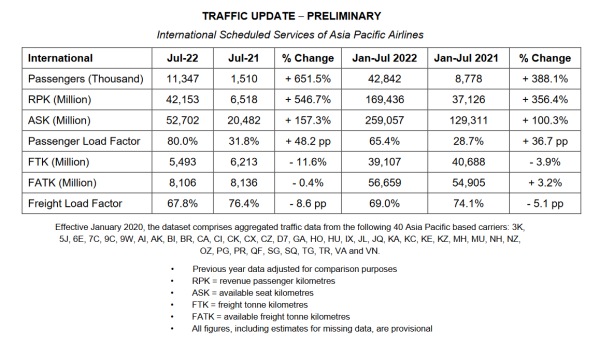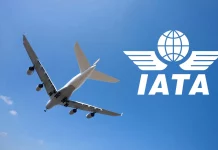KUALA LUMPUR, 26 August 2022: Asia Pacific airlines report a strong recovery in international par passenger traffic according to the Preliminary July 2022 traffic figures released Thursday by the Association of Asia Pacific Airlines (AAPA).
The region’s airlines flew a combined 11.3 million international passengers in July, surpassing the 10 million mark for the first time since February 2020, when the Covid-19 pandemic led to a collapse in global travel markets.
The average international passenger load factor reached a pandemic high of 80% for the month, the highest since the Covid-19 pandemic hit the region in early 2020. Demand measured in revenue passenger kilometres (RPK) rose by 546.7% year-on-year, significantly outpacing the 157.3% expansion in available seat capacity.

By contrast, air cargo markets weakened further against falling export orders and worsening business and consumer confidence levels. For the month, international air cargo demand in freight tonne kilometres (FTK) dropped by 11.6% year on year, whilst freight capacity offered held relatively steady, edging just 0.4% lower. As a result, the average international freight load factor declined by 8.6 percentage points to 67.8% for the month.
Commenting on the results, AAPA director general Subhas Menon said: “Growth in travel markets continued to accelerate in July, bringing the total number of international passengers to 43 million in the first seven months, almost five-fold more than the 9 million recorded during the same period in 2019. However, full recovery remains a long way off, with traffic in July averaging only 34% of the corresponding pre-pandemic month.”
He added: “Meanwhile, prevailing supply chain disruptions, inflationary pressures and geopolitical tensions further dampened demand for air shipments. Nevertheless, the robust passenger travel recovery supports the industry’s return to profitability, even though cost pressures abound.”
Looking ahead, Menon noted: “Overall, 2022 looks to be a better year by far, although there will be bumps in the road to recovery. Immediate challenges include operational constraints resulting from manpower shortages and rising costs amid a distinct slowdown in global economic Growth.
“To further enhance the industry’s resilience, AAPA continues to urge stakeholders to work closely to expand smooth, safe and sustainable air connectivity, given the significant contribution of air transport to economic growth and social development,” he concluded.
(Source: AAPA)






